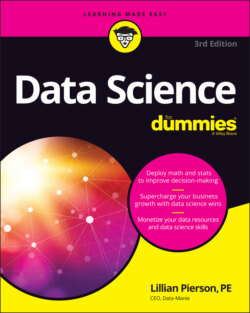Читать книгу Data Science For Dummies - Lillian Pierson - Страница 64
Exploring Probability and Inferential Statistics
ОглавлениеProbability is one of the most fundamental concepts in statistics. To even get started making sense of your data by using statistics, you need to be able to identify something as basic as whether you’re looking at descriptive or inferential statistics. You also need a firm grasp of the basics of probability distribution. The following sections cover these concepts and more.
A statistic is a result that’s derived from performing a mathematical operation on numerical data. In general, you use statistics in decision-making. Statistics come in two flavors:
Descriptive: Descriptive statistics provide a description that illuminates some characteristic of a numerical dataset, including dataset distribution, central tendency (such as mean, min, or max), and dispersion (as in standard deviation and variance). For clarification, the mean of a data set is the average value of its data points, its min is the minimum value of its data points and the max is the maximum value. Descriptive statistics are not meant to illustrate any causal claims. Descriptive statistics can highlight relationships between X and Y, but they do not posit that X causes Y.
Inferential: Rather than focus on pertinent descriptions of a dataset, inferential statistics carve out a smaller section of the dataset and attempt to deduce significant information about the larger dataset. Unlike descriptive statistics, inferential methods, such as regression analysis, DO try to predict by studying causation. Use this type of statistics to derive information about a real-world measure in which you’re interested.
It’s true that descriptive statistics describe the characteristics of a numerical dataset, but that doesn’t tell you why you should care. In fact, most data scientists are interested in descriptive statistics only because of what they reveal about the real-world measures they describe. For example, a descriptive statistic is often associated with a degree of accuracy, indicating the statistic’s value as an estimate of the real-world measure.
To better understand this concept, imagine that a business owner wants to estimate the upcoming quarter’s profits. The owner might take an average of the past few quarters’ profits to use as an estimate of how much profit they’ll make during the next quarter. But if the previous quarters’ profits varied widely, a descriptive statistic that estimated the variation of this predicted profit value (the amount by which this dollar estimate could differ from the actual profits earned) would indicate just how far the predicted value could be from the actual one. (Not bad information to have, right?)
You can use descriptive statistics in many ways — to detect outliers, for example, or to plan for feature preprocessing requirements or to quickly identify which features you may want — or not want — to use in an analysis.
Like descriptive statistics, inferential statistics are used to reveal something about a real-world measure. Inferential statistics do this by providing information about a small data selection, so you can use this information to infer something about the larger dataset from which it was taken. In statistics, this smaller data selection is known as a sample, and the larger, complete dataset from which the sample is taken is called the population.
If your dataset is too big to analyze in its entirety, pull a smaller sample of this dataset, analyze it, and then make inferences about the entire dataset based on what you learn from analyzing the sample. You can also use inferential statistics in situations where you simply can’t afford to collect data for the entire population. In this case, you’d use the data you do have to make inferences about the population at large. At other times, you may find yourself in situations where complete information for the population isn’t available. In these cases, you can use inferential statistics to estimate values for the missing data based on what you learn from analyzing the data that’s available.
For an inference to be valid, you must select your sample carefully so that you form a true representation of the population. Even if your sample is representative, the numbers in the sample dataset will always exhibit some noise — random variation, in other words — indicating that the sample statistic isn’t exactly identical to its corresponding population statistic. For example, if you’re constructing a sample of data based on the demographic makeup of Chicago’s population, you would want to ensure that proportions of racial/ethnic groups in your sample match up to proportions in the population overall.
